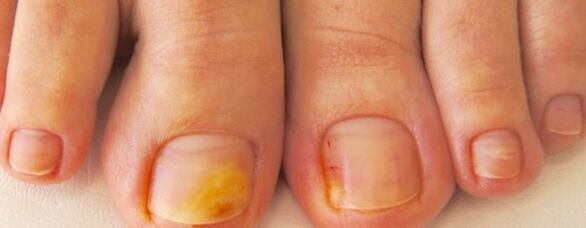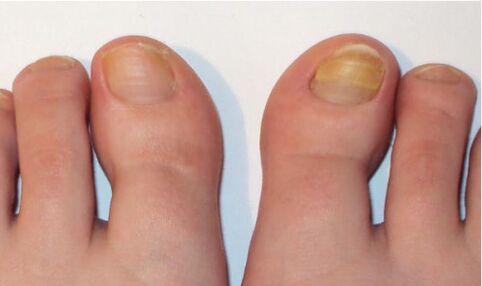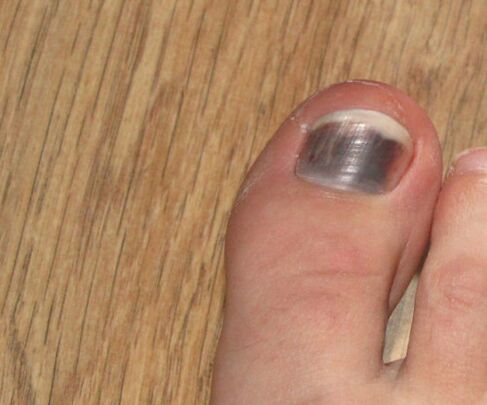Most people do not even know that the most common foot sweat and the unpleasant odor that accompanies it is one of the main signs of developing a fungal disease. Nail fungus, the symptoms of which do not appear immediately, can appear to any person who does not take care of himself at least a little. This disease waits almost everywhere, and more often in public places. What is sad is that a fungal disease is quite insidious: it is treated for a long period of time and is not effective in 100% of cases, as it is characterized by relapses. To identify the fungus in time and start treatment, you need to have an idea of how toenail fungus appears.

Spread of a fungal disease
The disease is caused by the development of parasitic fungi in the body. The best conditions for their emergence and subsequent spread are a warm environment at the same time with high humidity. Many are of the opinion that it is very easy to get such an infection in water parks, baths, beauty salons.
But the statistics are completely different: you can get a fungal infection even without leaving the house through common items (bathrooms, clothes, shoes, towels). However, this is true if at least one of the family members is a fungus carrier. And yet, what influences the spread of fungi in principle? There are such major aspects that cause infection with a fungal disease:
- Heavy sweating;
- Diabetes;
- The problem of excess weight;
- If the nail is injured;
- Weak immunity.
To somehow protect yourself from fungal infection, you should only use personal hygiene products, carry out a comprehensive shower and bath treatment, wear only shoes, arrange carpet washing as often as possible, and so on. And if you have already noticed the first signs of nail fungus, you should contact a dermatologist immediately!
Signs of a fungus, based on the causative agent of the disease

Signs of mold on toenails should be noticed in time. The effectiveness of complex treatment of a fungal infection is determined by the degree to which the causative agent of the disease was correctly identified. This can be explained by the fact that there are many types of fungi, and each species reacts to a certain group of drugs.
In most cases, the causative agents of the disease are:
- mold;
- Dermatophytes;
- Maja.
If the fungus started to develop due to yeast, then it is almost impossible to detect the disease overnight. Signs of foot fungus in such circumstances are as follows:
- The foot and skin around the nail plate itches;
- The nail is peeled.
Yeast infection occurs in only 4-5% of cases. Very often, it is dermatophytes that affect the nail plate (94. 5%). This pathogen is of 3 types, and the manifestation of each is very different:
- 1 type. There is a simultaneous loss of nail plate, toe skin and toes as a whole. Such a fungus moves easily on the nails and skin of the hands.
- 2 type. The disease affects only the nails of the big toe and the little toe. It can also go in the folds between the toes.
- 3 type. It is characterized by damage to the nail plate of the little finger and thumb, but the disease does not spread to the skin.
As for the mold, the cause in this case are mold. It is observed extremely rarely. It is mostly found in AIDS patients.
Other symptoms

Often, when the disease has just begun to develop, there are no symptoms of fungus on the toenails. But in the case of extreme attention to the feet, a person will notice that round spots began to appear on the nail plate, and the nail itself loses its luster and becomes rough. As it develops, a fungal disease affects the nail plate to a greater extent: its color will initially change, after which the nails bloom, can be easily broken. The shade of the nail plate is determined by the type of pathogenic fungus.
Nail fungus: symptoms (additional)
- The nail plate turns black;
- The nail takes on an unusual shape and its structure changes completely;
- The nails become very brittle;
- Plastic incisions of the nails under the skin;
- Followed by constant fatigue.
The abnormal appearance of the nail plate is a "bell" to visit a dermatologist, and there the nail fungus, the symptoms of which you have noticed, will be confirmed or rejected. If you constantly delay going to the doctor, the disease will quickly spread to other areas. If you do not think about it, then there is nothing life threatening about this disease. But in addition to an exclusively aesthetic problem and concern, a fungal infection is sometimes the cause of major complications. For this reason the symptoms should not be overlooked and treatment of the disease should be started in a timely manner, once it has been identified.
The doctor who treats fungal diseases
It is realistic to detect an infection yourself, but only a doctor can confirm your assumptions. To make an accurate diagnosis, a dermatologist will recommend several tests. For their application, a part of the destroyed nail plate or the scratch of the periungal tissue is taken.
Early detection of infection makes further treatment easier and eliminates the possibility of complications. If treatment is not started in time, this will ensure the spread of the disease to other organs and all fingernails / toenails.
Nail fungus: treatment procedure
Therapy aimed at treating fungus is prescribed by a dermatologist - it will all depend on how advanced the disease is, the type of fungus that is present in the body and other factors. Usually, if the fungus is just beginning to develop, the medication is prescribed for external use. In more difficult situations resort to intensive treatment.
By the way, it takes a lot of time. Therefore, it is in your best interest to see a doctor at the slightest suspicion of a fungal infection! Symptoms of nail fungus should be known in advance. And the sooner the disease is detected, the faster the treatment will take place!





























